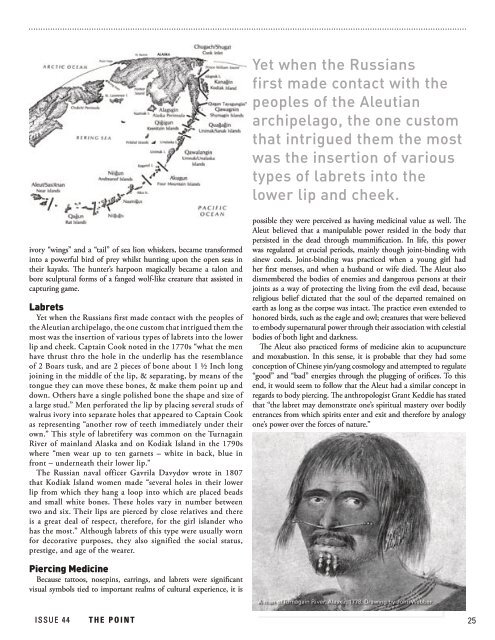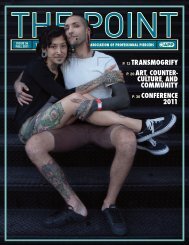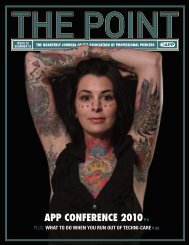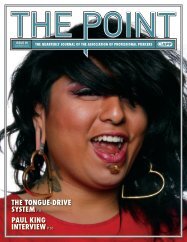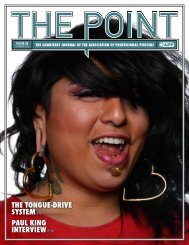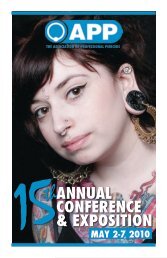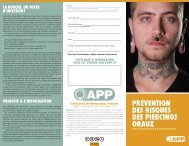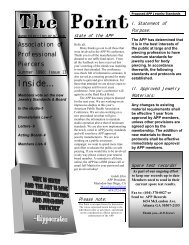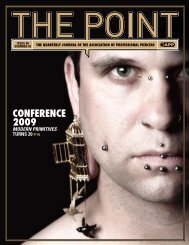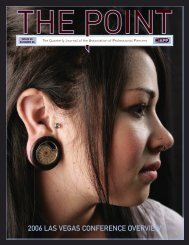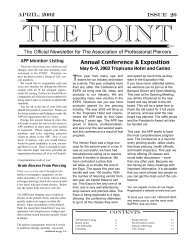The Piercing & tattooing among the aleut the - Association of ...
The Piercing & tattooing among the aleut the - Association of ...
The Piercing & tattooing among the aleut the - Association of ...
Create successful ePaper yourself
Turn your PDF publications into a flip-book with our unique Google optimized e-Paper software.
Yet when <strong>the</strong> Russians<br />
first made contact with <strong>the</strong><br />
peoples <strong>of</strong> <strong>the</strong> Aleutian<br />
archipelago, <strong>the</strong> one custom<br />
that intrigued <strong>the</strong>m <strong>the</strong> most<br />
was <strong>the</strong> insertion <strong>of</strong> various<br />
types <strong>of</strong> labrets into <strong>the</strong><br />
lower lip and cheek.<br />
ivory “wings” and a “tail” <strong>of</strong> sea lion whiskers, became transformed<br />
into a powerful bird <strong>of</strong> prey whilst hunting upon <strong>the</strong> open seas in<br />
<strong>the</strong>ir kayaks. <strong>The</strong> hunter’s harpoon magically became a talon and<br />
bore sculptural forms <strong>of</strong> a fanged wolf-like creature that assisted in<br />
capturing game.<br />
Labrets<br />
Yet when <strong>the</strong> Russians first made contact with <strong>the</strong> peoples <strong>of</strong><br />
<strong>the</strong> Aleutian archipelago, <strong>the</strong> one custom that intrigued <strong>the</strong>m <strong>the</strong><br />
most was <strong>the</strong> insertion <strong>of</strong> various types <strong>of</strong> labrets into <strong>the</strong> lower<br />
lip and cheek. Captain Cook noted in <strong>the</strong> 1770s “what <strong>the</strong> men<br />
have thrust thro <strong>the</strong> hole in <strong>the</strong> underlip has <strong>the</strong> resemblance<br />
<strong>of</strong> 2 Boars tusk, and are 2 pieces <strong>of</strong> bone about 1 ½ Inch long<br />
joining in <strong>the</strong> middle <strong>of</strong> <strong>the</strong> lip, & separating, by means <strong>of</strong> <strong>the</strong><br />
tongue <strong>the</strong>y can move <strong>the</strong>se bones, & make <strong>the</strong>m point up and<br />
down. O<strong>the</strong>rs have a single polished bone <strong>the</strong> shape and size <strong>of</strong><br />
a large stud.” Men perforated <strong>the</strong> lip by placing several studs <strong>of</strong><br />
walrus ivory into separate holes that appeared to Captain Cook<br />
as representing “ano<strong>the</strong>r row <strong>of</strong> teeth immediately under <strong>the</strong>ir<br />
own.” This style <strong>of</strong> labretifery was common on <strong>the</strong> Turnagain<br />
River <strong>of</strong> mainland Alaska and on Kodiak Island in <strong>the</strong> 1790s<br />
where “men wear up to ten garnets – white in back, blue in<br />
front – underneath <strong>the</strong>ir lower lip.”<br />
<strong>The</strong> Russian naval <strong>of</strong>ficer Gavrila Davydov wrote in 1807<br />
that Kodiak Island women made “several holes in <strong>the</strong>ir lower<br />
lip from which <strong>the</strong>y hang a loop into which are placed beads<br />
and small white bones. <strong>The</strong>se holes vary in number between<br />
two and six. <strong>The</strong>ir lips are pierced by close relatives and <strong>the</strong>re<br />
is a great deal <strong>of</strong> respect, <strong>the</strong>refore, for <strong>the</strong> girl islander who<br />
has <strong>the</strong> most.” Although labrets <strong>of</strong> this type were usually worn<br />
for decorative purposes, <strong>the</strong>y also signified <strong>the</strong> social status,<br />
prestige, and age <strong>of</strong> <strong>the</strong> wearer.<br />
possible <strong>the</strong>y were perceived as having medicinal value as well. <strong>The</strong><br />
Aleut believed that a manipulable power resided in <strong>the</strong> body that<br />
persisted in <strong>the</strong> dead through mummification. In life, this power<br />
was regulated at crucial periods, mainly though joint-binding with<br />
sinew cords. Joint-binding was practiced when a young girl had<br />
her first menses, and when a husband or wife died. <strong>The</strong> Aleut also<br />
dismembered <strong>the</strong> bodies <strong>of</strong> enemies and dangerous persons at <strong>the</strong>ir<br />
joints as a way <strong>of</strong> protecting <strong>the</strong> living from <strong>the</strong> evil dead, because<br />
religious belief dictated that <strong>the</strong> soul <strong>of</strong> <strong>the</strong> departed remained on<br />
earth as long as <strong>the</strong> corpse was intact. <strong>The</strong> practice even extended to<br />
honored birds, such as <strong>the</strong> eagle and owl; creatures that were believed<br />
to embody supernatural power through <strong>the</strong>ir association with celestial<br />
bodies <strong>of</strong> both light and darkness.<br />
<strong>The</strong> Aleut also practiced forms <strong>of</strong> medicine akin to acupuncture<br />
and moxabustion. In this sense, it is probable that <strong>the</strong>y had some<br />
conception <strong>of</strong> Chinese yin/yang cosmology and attempted to regulate<br />
“good” and “bad” energies through <strong>the</strong> plugging <strong>of</strong> orifices. To this<br />
end, it would seem to follow that <strong>the</strong> Aleut had a similar concept in<br />
regards to body piercing. <strong>The</strong> anthropologist Grant Keddie has stated<br />
that “<strong>the</strong> labret may demonstrate one’s spiritual mastery over bodily<br />
entrances from which spirits enter and exit and <strong>the</strong>refore by analogy<br />
one’s power over <strong>the</strong> forces <strong>of</strong> nature.”<br />
<strong>Piercing</strong> Medicine<br />
Because tattoos, nosepins, earrings, and labrets were significant<br />
visual symbols tied to important realms <strong>of</strong> cultural experience, it is<br />
A man <strong>of</strong> Turnagain River, Alaska, 1778. Drawing by John Webber.<br />
ISSUE 44 T H E P O I N T 25


